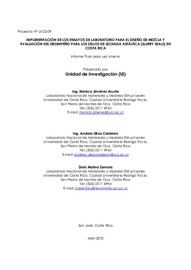Mostrar el registro sencillo del ítem
Implementación de los ensayos de laboratorio para el diseño de mezcla y evaluación del desempeño para los sellos de lechada asfáltica (slurry seals) en Costa Rica
| dc.contributor.author | Jiménez Acuña, Mónica | |
| dc.contributor.author | Ulloa Calderón, Andrea | |
| dc.contributor.author | Molina Zamora, Doris | |
| dc.date.accessioned | 2018-05-21T21:06:48Z | |
| dc.date.available | 2018-05-21T21:06:48Z | |
| dc.date.issued | 2010-04 | |
| dc.identifier.uri | https://www.lanamme.ucr.ac.cr/repositorio/handle/50625112500/1187 | |
| dc.description.abstract | Del siguiente informe se obtiene que con los resultados del ensayo de consistencia donde se obtuvo un rango de 23 % y 27 % de líquidos totales, aún así se puede observar separación del líquidos. Es probable que el contenido de emulsión sea muy alto razón por la cual se están obteniendo los resultados presentados en este estudio. Luego de revisar los resultados, queda la duda de si el contenido de líquidos totales está dentro del rango especificado, y se varía el contenido de emulsión y agua para mantener esta relación, el resultado del ensayo de consistencia debe ser muy parecido, pero se indica que en la nota 1 del método ISSA TB 113 que este contenido puede variar de acuerdo con el tipo de relleno utilizado que hace que aumente entre 1 % y 1.5 % en la adición de agua, o también que de acuerdo con la temperatura también varía pues a más temperatura más agua se requiere y para bajas temperaturas se requiere de menos agua. | es |
| dc.description.abstract | From the following report it is obtained that with the results of the consistency test where a range of 23% and 27% of total liquids was obtained, even so, liquid separation can be observed. It is likely that the emulsion content is very high, which is why the results presented in this study are being obtained. After reviewing the results, the question remains as to whether the content of total liquids is within the specified range, and the content of emulsion and water is varied to maintain this relation, the result of the consistency test must be very similar, but it is indicated that in note 1 of the ISSA TB 113 method that this content can vary according to the type of filler used that makes it increase between 1% and 1.5% in the addition of water, or also that according to the temperature it also varies the more temperature more water is required and for lower temperatures less water is required. | es |
| dc.language.iso | es | es |
| dc.publisher | Laboratorio Nacional de Materiales y Modelos Estructurales (LanammeUCR) | es |
| dc.subject | emulsión | es |
| dc.subject | ensayo de consistencia | es |
| dc.subject | líquidos | es |
| dc.subject | agua | es |
| dc.subject | emulsion | es |
| dc.subject | consistency test | es |
| dc.subject | liquids | es |
| dc.subject | water | es |
| dc.title | Implementación de los ensayos de laboratorio para el diseño de mezcla y evaluación del desempeño para los sellos de lechada asfáltica (slurry seals) en Costa Rica | es |
| dc.title.alternative | UI-02-09 | |
| dc.type | informe técnico | es |
| dc.description.procedence | UCR::Vicerrectoría de Investigación::Unidades de Investigación::Ingeniería::LanammeUCR | es |
Ficheros en el ítem
Este ítem aparece en la(s) siguiente(s) colección(ones)
-
Informes [1088]

